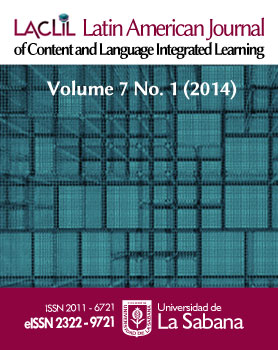An exercise in course-book evaluation: Strengths, weaknesses, and recommendations regarding New English file: Elementary
DOI:
https://doi.org/10.5294/3870Keywords:
aprendizaje de segunda lengua, evaluación de materiales, valuación de libros e texto, enseñanza de lengua inglesa, autenticidad de los materiales.Abstract
Often overlooked and reduced to a quick and shallow ‘flick test’, materials evaluation is a necessary skill for English Language Teachers to acquire. It serves the logistical purpose of making an effective selection of materials that cater to their students’ needs as well as their own, and puts them in contact with opportunities for further development of their practices based upon the contents and activities found throughout the evaluation process of a given teaching material. The purpose of this article will be then, to conduct an exercise in materials evaluation using Oxford University Press’ New English File series. By making a review of the different theoretical stances and experiences on the matter, it will be possible to develop a series of criteria with which to conduct a structured, qualitative evaluation. Based on the results of the application of the aforementioned criteria, it will be possible to conclude on the suitability of this teaching material on a particular context.
Downloads
References
Barnard, R. Randall, M. (1995). Evaluating Course Materials: A Contrastive Study in Text Book Trialling. System, 23(3), 337 – 346
Chambers, F. (1997). Seeking Consensus in Coursebook Evaluations. ELT Journal, 51(1), 29 – 35
Council of Europe (2011). Common European Framework of Reference for Languages. Language Policy Unit. Strasbourg. Available from http://www.coe.int/t/dg4/linguistic/Source/Framework_en.pdf [Accessed 29 March 2013]
Ellis, R. (1997). The Empirical Evaluation of Language Teaching Materials. ELT Journal, 51(1), 36-42
Ellis, R. (2011). Macro- and Micro- Evaluations of Task-Based Teaching. In Tomlinson, B. (ed.) (2011). Materials Development in Language Teaching (pp. 212 – 235), Cambridge: Cambridge University Press
Ellis, R. (2010). Second Language Acquisition, Teacher Education, and Language Pedagogy. Language Teaching, 43(2), 182-201
Illés, E. (2009). What Makes a Coursebook Series Stand the Test of Time? ELT Journal, 63(2), 145-163
Kayapinar, U. (2009). Coursebook Evaluation by English Teachers. Inonu University Journal of the Faculty of Education. 10(1), 69-78
Littlejohn, A. (2011) The Analysis of Language Teaching Materials: Inside the Trojan Horse. In Tomlinson, B. (ed.) (2011). Materials Development in Language Teaching (pp. 212 – 235), Cambridge: Cambridge University Press
Oxenden, C. Latham-Koenig, C. Seligson, P. (2009a) New English File: Elementary Student’s Book, Oxford: Oxford University Press
Oxenden, C. Latham-Koenig, C. Seligson, P. (2009b) New English File: Elementary Teacher’s Book, Oxford: Oxford University Press
Oxenden, C. Latham-Koenig, C. Seligson, P. (2009c) New English File: Elementary Workbook, Oxford: Oxford University Press
Rinvolucri, M. (1999). The UK, EFLese Sub-Culture and Dialect. Folio 5(2), 12-14
Roberts, J.T. (1996). Demystifying Materials Evaluation. System, 24(3), 378-389
Sheldon, L. (1988). Evaluating ELT Textbooks and Materials. ELT Journal, 42(4), 237 – 246
Thornbury, S. (1999). Window-Dressing Vs. Cross-Dressing in the EFL sub-culture. Folio 5(2): 15-17
Zohrabi, M. Sabouri, H. Behroozian, R. (2012). An Assessment of Strengths and Weaknesses of Iranian First Year High School Coursebook Using Evaluation Checklist. English Language And Literature Studies, 2(2), 89-99. doi: 10.5539/elt.v4n2p213
Downloads
Published
How to Cite
Issue
Section
License
This Journal and its articles are published under the Creative Commons CC BY 4.0 DEED Attribution 4.0 International license. You are free to: Share — copy and redistribute the material in any medium or format for any purpose, even commercially. Adapt — remix, transform, and build upon the material for any purpose, even commercially. The license cannot revoke these freedoms as long as you follow the terms of the license.








